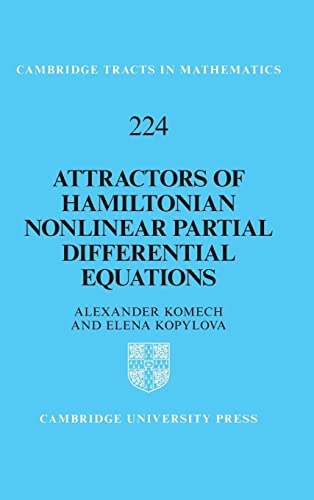Description
Attractors of Hamiltonian Nonlinear Partial Differential Equations by Alexander Komech, ISBN-13: 978-1316516911
[PDF eBook eTextbook]
- Publisher: Cambridge University Press; 1st edition (September 30, 2021)
- Language: English
- 212 pages
- ISBN-10: 1316516911
- ISBN-13: 978-1316516911
The first monograph on the theory of global attractors of Hamiltonian partial differential equations.
This monograph is the first to present the theory of global attractors of Hamiltonian partial differential equations. A particular focus is placed on the results obtained in the last three decades, with chapters on the global attraction to stationary states, to solitons, and to stationary orbits. The text includes many physically relevant examples and will be of interest to graduate students and researchers in both mathematics and physics. The proofs involve novel applications of methods of harmonic analysis, including Tauberian theorems, Titchmarsh’s convolution theorem, and the theory of quasimeasures. As well as the underlying theory, the authors discuss the results of numerical simulations and formulate open problems to prompt further research.
Table of Contents:
Preface page ix
Introduction 1
1 Global Attraction to Stationary States 13
1.1 Free d’Alembert Equation 13
1.2 A String Coupled to a Nonlinear Oscillator 14
1.3 String Coupled to Several Nonlinear Oscillators 28
1.4 Space-Localized Nonlinearity 43
1.5 Wave–Particle System 56
1.6 Maxwell–Lorentz Equations: Radiation Damping 66
1.7 Wave Equations with Concentrated Nonlinearities 68
1.8 Comparison with Dissipative Systems 76
2 Global Attraction to Solitons 77
2.1 Translation-Invariant Wave–Particle System 77
2.2 The Case of Weak Coupling 89
3 Global Attraction to Stationary Orbits 91
3.1 Nonlinear Klein–Gordon Equation 91
3.2 Generalizations and Open Questions 94
3.3 Omega Limit Trajectories 95
3.4 Limiting Absorption Principle 96
3.5 A Nonlinear Analog of Kato’s Theorem 99
3.6 Splitting into Dispersive and Bound Components 102
3.7 Omega-Compactness 103
3.8 Reduction of Spectrum to Spectral Gap 104
3.9 Reduction of Spectrum to a Single Point 105
3.10 On the Nonlinear Radiative Mechanism 107
3.11 Conjecture on Attractors of G-Invariant PDEs 111
4 Asymptotic Stability of Stationary Orbits and Solitons 114
4.1 Orthogonal Projection 114
4.2 Symplectic Projection 116
4.3 Generalizations and Applications 120
4.4 Further Generalizations 122
4.5 The 1D Schrodinger Equation Coupled to an Oscillator 124
5 Adiabatic Effective Dynamics of Solitons 166
5.1 Solitons in Slowly Varying External Potentials 166
5.2 Mass–Energy Equivalence 168
6 Numerical Simulation of Solitons 170
6.1 Kinks of Relativistic Equations 170
6.2 Numerical Observation of Soliton Asymptotics 174
6.3 Adiabatic Effective Dynamics of Relativistic Solitons 174
7 Dispersive Decay 178
7.1 The Schrodinger and Klein–Gordon Equations 178
7.2 Decay L1 L
∞ for 3D Schrodinger Equations 180
8 Attractors and Quantum Mechanics 192
8.1 Bohr’s Postulates 192
8.2 On Dynamical Interpretation of Quantum Jumps 194
8.3 Bohr’s Postulates via Perturbation Theory 197
8.4 Conclusion 198
Bibliography 200
Index 212
Alexander Komech is Senior Scientist in the Faculty of Mathematics at the University of Vienna, the Institute for Information Transmission Problems at the Russian Academy of Sciences, and the Mechanics–Mathematics Department of Moscow State University (Lomonosov). He was awarded the Humboldt Research Award in 2006. He previously authored three monographs and the textbook Principles of Partial Differential Equations (2009).
Elena Kopylova is Senior Scientist in the Faculty of Mathematics at the University of Vienna and the Institute for Information Transmission Problems at the Russian Academy of Sciences. Her research interests include the convergence to equilibrium measures for hyperbolic PDEs and global attractors of nonlinear Hamiltonian PDEs. She is the author of Dispersion Decay and Scattering Theory (2012).
What makes us different?
• Instant Download
• Always Competitive Pricing
• 100% Privacy
• FREE Sample Available
• 24-7 LIVE Customer Support




